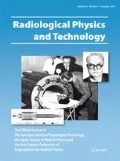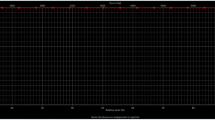Abstract
This study compared dosimetric indices of volumetric-modulated arc therapy (VMAT) with intensity-modulated radiation therapy (IMRT) accounting for cold spots in prostate cancer plans. IMRT plans were retrospectively generated from 30 prostate cancer patients with ten cases for each risk group, who received VMAT plans. The mean, maximum, and minimum doses, and conformity and homogeneity indexes were evaluated for planning target volume (PTV) and the mean dose and V20–V70 for organs at risk (OAR) including the rectum, bladder, right and left femoral heads, and rectum overlapped with PTV (ROP) regions. The numbers and volume percentages of cold spots within PTVs and ROP regions were measured using in-house software. Three-dimensional probabilistic distributions of the probability and distributions of cold spots were generated using a centroid matching technique for visualization and analysis. There was a statistically better dose conformity in the PTV, rectum, and bladder dose-sparing in VMAT compared to that in the IMRT plans, whereas VMAT had statistically worse target dose homogeneity, and right and left femoral head dose-sparing than those of the IMRT plans. The average volume percentage of cold spots per PTV for the VMAT was 4.37 ± 2.68%, which was smaller than the 5.72 ± 1.84% observed for IMRT plans (P = 0.007). The volume percentage of cold spots per ROP for the VMAT did not significantly differ from those for the IMRT plans. Compared with IMRT, the VMAT plans achieved better PTV dose conformity, OAR dose-sparing, and smaller cold spots in the treatment of prostate cancer.








Similar content being viewed by others
References
Ferlay J, Soerfomataram I, Dikshit R, et al. Cancer incidence and mortality worldwide: sources, methods and major patterns in GLOBOCAN 2012. Int J Cancer. 2015;136:359–86.
Kitazawa T, Matsumoto K, Fujita S, et al. Cost of illness of the prostate cancer in Japan—a time-trend analysis and future projections. BMC Health Serv Res. 2015;15:453.
Ogawa K, Nakamura K, Sasaki T, et al. Radical external beam radiotherapy for clinically localized prostate cancer in Japan: changing trends in the patterns of care process survey. Int J Radiat Oncol Biol Phys. 2011;81:1310–8.
King CR, Dipetrillo TA, Wazer DE, et al. Optimal radiotherapy for prostate cancer: predictions for conventional external beam, IMRT, and brachytherapy from radiobiologic models. Int J Radiat Oncol Biol Phys. 2000;46:165–72.
Ezzell GA, Galvin JM, Low D, et al. Guidance document on delivery, treatment planning, and clinical implementation of IMRT: report of the IMRT Subcommittee of the AAPM Radiation Therapy Committee. Med Phys. 2003;30:2089–115.
Hodapp N. The ICRU Report 83: prescribing, recording and reporting photon-beam intensity-modulated radiation therapy (IMRT). Strahlenther Onkol. 2012;188:97–9.
Rana S. Intensity modulated radiation therapy versus volumetric intensity modulated arc therapy. J Med Radiat Sci. 2013;60:81–3.
Otto K. Volumetric modulated arc therapy: IMRT in a single gantry arc. Med Phys. 2008;35:310–7.
Jeraj R, Keall PJ, Siebers JV. The effect of dose calculation accuracy on inverse treatment planning. Phys Med Biol. 2002;47:391–407.
Mundt AJ, Roeske JC. Intensity modulated radiation therapy: a clinical perspective. Hamilton: BC Decker Inc.; 2005.
Dogan N, Siebers JV, Keall PJ, et al. Improving IMRT dose accuracy via deliverable Monte Carlo optimization for the treatment of head and neck cancer patients. Med Phys. 2006;33:4033–43.
Bortfeld T, Craft D, Dempsey JF, et al. Evaluating target cold spots by the use of tail EUDs. Int J Radiat Oncol Biol Phys. 2008;71:880–9.
Tomé WA, Fowler JF. On cold spots in tumor subvolumes. Med Phys. 2002;29:1590–8.
Vora SA, Wong WW, Schild SE, et al. Outcome and toxicity for patients treated with intensity modulated radiation therapy for localized prostate cancer. J Urol. 2013;190:521–6.
Zaorsky NG, Shaikh T, Murphy CT, et al. Comparison of outcomes and toxicities among radiation therapy treatment options for prostate cancer. Cancer Treat Rev. 2016;48:50–60.
Palma D, Vollans E, James K, et al. Volumetric modulated arc therapy for delivery of prostate radiotherapy: comparison with intensity-modulated radiotherapy and three-dimensional conformal radiotherapy. Int J Radiat Oncol Biol Phys. 2008;72:993–1001.
Wolff D, Stieler F, Welzel G, et al. Volumetric modulated arc therapy (VMAT) vs. serial tomotherapy, step-and-shoot IMRT and 3D-conformal RT for treatment of prostate cancer. Radiother Oncol. 2009;93:226–33.
Quan EM, Li X, Li Y, et al. A comprehensive comparison of IMRT and VMAT plan quality for prostate cancer treatment. Int J Radiat Oncol Biol Phys. 2012;83:1169–78.
Guckenberger M, Richter A, Krieger T, et al. Is a single arc sufficient in volumetric-modulated arc therapy (VMAT) for complex-shaped target volumes? Radiother Oncol. 2009;93:259–65.
Kjaer-Kristofferesen F, Ohlhues L, Medin J, et al. RapidArc volumetric modulated therapy planning for prostate cancer patients. Acta Oncol. 2009;48:227–32.
Yoo S, Wu QJ, Lee WR, et al. Radiotherapy treatment plans with RapidArc for prostate cancer involving seminal vesicles and lymph nodes. Int J Radiat Oncol Biol Phys. 2009;76:935–42.
Ost P, Speleers B, De Meerleer G, et al. Volumetric arc therapy and intensity modulated radiotherapy for primary prostate radiotherapy with simultaneous integrated boost to intraprostatic lesion with 6 and 18 MV: A planning comparison study. Int J Radiat Oncol Biol Phys. 2011;79:920–6.
Sze HC, Lee MC, Hung WM, et al. RapidArc radiotherapy planning for prostate cancer: single-arc and double-arc techniques vs. intensity modulated radiotherapy. Med Dosim. 2012;37:87–91.
Shaffer R, Morris WJ, Moiseenko V, et al. Volumetric modulated arc therapy and conventional intensity-modulated radiotherapy for simultaneous maximal intraprostatic boost: a planning comparison study. Clin Oncol R Coll Radiol. 2009;21:401–7.
Kopp RW, Duff M, Catalfamo F, et al. VMAT vs. 7-field-IMRT: assessing the dosimetric parameters of prostate cancer treatment with a 292-patient sample. Med Dosim. 2011;36:365–72.
Haekal M, Arimura H, Hirose T, et al. Computational analysis of interfractional anisotropic shape variations of the rectum in prostate cancer radiation therapy. Phys Medica. 2018;46:168–79.
Boehmer D, Maingon P, Poortmans P, et al. Guidelines for primary radiotherapy of patients with prostate cancer. Radiother Oncol. 2006;79:259–69.
Hayden AJ, Martin JM, Kneebone AB, et al. Australian and New Zealand faculty of radiation oncology genito-urinary group: 2010 consensus guidelines for definitive external beam radiotherapy for prostate carcinoma. J Med Imaging Radiat Oncol. 2010;54:513–25.
Bragg C, Windate K, Conway J. Clinical implications of the anisotropic analytical algorithm for IMRT treatment planning and verification. Radiother Oncol. 2008;86:276–84.
Michalski J. Purdy J, Bruner DW, et al., Radiation Therapy Oncology Group (RTOG) Report No. 0126, 2004.
Parker J, Kenyon R, Troxel D. Comparison of interpolating methods for image resampling. IEEE Trans Med Imag. 1983;2:31–9.
International Commission on Radiation Units and Measurements. ICRU Report 62. Prescribing, Recording, and Reporting Photon Beam Therapy (Supplement to ICRU Report 50). J ICRU. 1999.
Paddick I. A simple scoring ratio to index the conformity of radiosurgical treatment plans. Technical note. J Neurosurg. 2000;93:219–22.
Feuvret L, Noel G, Mazeron JJ, et al. Conformity index: a review. Int J Radiat Oncol Biol Phys. 2006;64:333–42.
Shapiro LG. Connected component labeling and adjacency graph con-struction. Mach Intell Pattern Recognit. 1996;19:1–30.
Lumia RA. New three-dimensional connected components algorithm. Compt Vis Graph Image Process. 1983;22:207–20.
Shibayama Y, Arimura H, Hirose TA, et al. Investigation of interfractional shape variations based on statistical point distribution model for prostate cancer radiation therapy. Med Phys. 2017;44:1837–45.
Taqaddas AE. Investigation of VMAT algorithms and dosimetry. London: AuthorHouse UK Publishing; 2011.
Khan M. Treatment planning in radiation oncology. Philadelphia: Lippincott Williams and Wilkins; 2007.
McLaughlin PW, Wygoda A, Sahijdak W, et al. The effect of patient position and treatment technique in conformal treatment of prostate cancer. Int J Radiat Oncol Biol Phys. 1999;45:407–13.
Serrano NA, Kalman NS, Anscher MS. Reducing rectal injury in men receiving prostate cancer radiation therapy: current perspectives. Cancer Manag Res. 2017;9:339–50.
Acknowledgements
Funding was provided by Japan Society for the Promotion of Science (Grant no: 16J04075).
Author information
Authors and Affiliations
Corresponding author
Ethics declarations
Conflict of interest
The authors declare that they have no conflict of interest.
Statements of human rights
All procedures performed in studies involving human participants were in accordance with the ethical standards of the Institutional Review Board (IRB) and with the 1964 Declaration of Helsinki and its later amendments or comparable ethical standards.
Statements of animal rights
This article does not contain any studies using animals.
Informed consent
Informed consent was obtained from all individual participants included in the study.
Additional information
Publisher’s Note
Springer Nature remains neutral with regard to jurisdictional claims in published maps and institutional affiliations.
About this article
Cite this article
Nguyen, T.T.T., Arimura, H., Asamura, R. et al. Comparison of volumetric-modulated arc therapy and intensity-modulated radiation therapy prostate cancer plans accounting for cold spots. Radiol Phys Technol 12, 137–148 (2019). https://doi.org/10.1007/s12194-019-00502-0
Received:
Revised:
Accepted:
Published:
Issue Date:
DOI: https://doi.org/10.1007/s12194-019-00502-0




